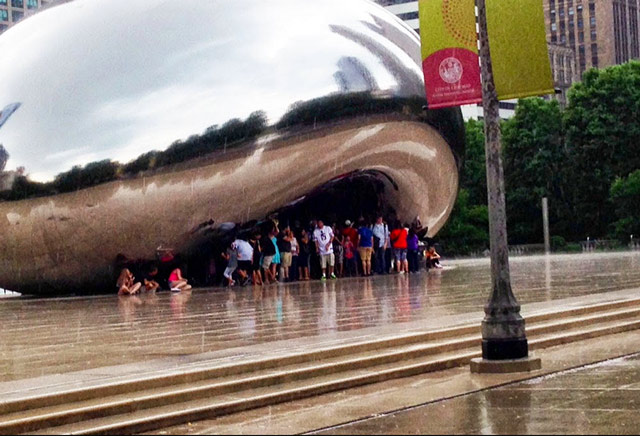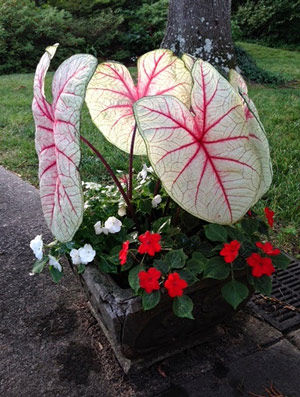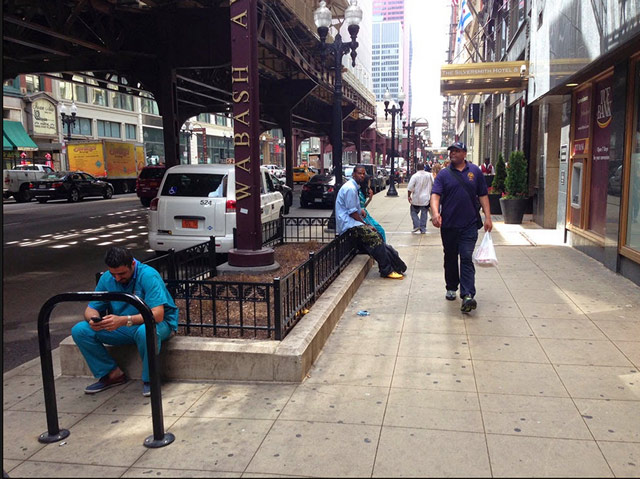
Watch Charlotte grow… foot and bicycle traffic
Photo: Buckingham Fountain in Grant Park is one of Chicago’s treasured public spaces. Credit: Mary Newsom. This article is cross-posted from Charlotte resident Mary Newsom’s Naked City Blog.
CHICAGO – Can Charlotte ever become an authentically walkable and bikable city?
I’ve just spent three days at a conference encouraging cities to overcome obstacles that keep them from achieving that goal.
The conference was sponsored by a group called 8-80 Cities. The idea behind that name is that cities should be designed for kids of 8 as well as adults of 80. The first group can’t drive and must walk or bicycle; the 80-year-olds may have already lost or be about to lose the ability to drive from hearing, vision, mental acuity or other age-related factors.

Millennium Park’s “Cloud Gate” offers dry space during a rain.

Red and white impatiens, with caladiums

The 606 rail-trail under construction. Photo: Mary Newsom
As 8-80 Cities executive director Gil Penalosa put it, “We have to stop building cities as if everyone is 30 years old and athletic.”
The 8-80 Cities Forum conference was named “The doable city” to encourage participants to consider the art of the possible in their cities. Co-sponsored by the John S. and James L. Knight Foundation, most participants were from some of the 26 cities where Knight has a special relationship, among them Charlotte; Akron, Ohio; Detroit; Macon, Ga. ; Miami; Philadelphia; Saint Paul, Minn.; and San Jose, Calif. (Disclosure: The Knight Foundation paid my travel expenses.)
We were shown numerous examples of efforts in cities from as far away as Melbourne, Australia, Copenhagen, Denmark, and Bogota, Colombia, to as close as Raleigh – events and campaigns and years-long projects to bring more public spaces (read parks and greenways) to cities and to find ways to encourage residents to view their city streets as public spaces, too – which of course they are.
Here’s an apt metaphor: impatiens or orchids? The idea was to encourage activists and public officials at the conference not to try to cultivate orchids, exotic, beautiful and needing expert care, but to aim for the equivalent of impatiens, a colorful – and much easier – flower to grow.
For Charlotte, even a “grow impatiens” approach might be akin to, say, trying to cultivate roses in thick clay. After all, a recent study of large metro areas, Dangerous By Design, ranked Charlotte the tenth most dangerous metro for pedestrians. A new ranking from the Trust For Public Land ranked Charlotte No. 57 of 60 cities for “ParkScore.” But Charlotte has changed some important city policies, and its residents are changing, also. The city has adopted a set of street-design standards to require sidewalks and encourage bike lanes and that will, over time, add significantly to bicycle- and pedestrian-friendliness. Not that I will live long enough to see all of them, but still…
And more and more cyclists have been spotted on city streets and commuting to jobs. Here’s a recent set of articles from PlanCharlotte about folks who’ve chosen not to drive. “Car free in Charlotte? It isn’t easy” and “They’d rather not drive, thank you.” In Chicago, speaker after speaker encouraged the conference attendees to work toward making their cities and towns more attractive to people, well, from age 8 to 80. As Dan Burden of the Walkable and Livable Communities Institute put it, we all need to stop worrying so much about whether people dislike residential density: “What they don’t want to do,” he said, “is live in ugly places.”
Stefanie Seskin of the National Complete Streets Coalition (whose report ranked Charlotte as 10th most dangerous), noted that speed is a factor in 1 in 3 traffic fatalities. Additionally, from 2003 to through 2012, more than 47,000 people died while walking on U.S. streets – 16 times the number who died in natural disasters during in the same period.
“We have a moral imperative to do better,” said Seskin.
The Charlotte contingent included several city officials, including Mike Davis and Liz Babson of Charlotte Department of Transportation and Deputy City Engineer Tim Richards, as well as Mecklenburg County Park and Recreation Director Jim Garges. We toured the Chicago’s stunning Millennium Park – built atop parking garages and a set of railway lines – as well as the under-construction 606 Project, a linear park on an unused, elevated freight line through neighborhoods west of downtown Chicago. (Both, I note, were made possible in part due to the city already owning the land.)
Millennium Park benefited from a number of extremely generous philanthropic donors; 115 donors gave at least $1 million. In other words, private donors in Chicago made their support for parks very public.
We who were on the Charlotte team are putting our heads together to see what events or improvements might happen relatively quickly here. We know local governments won’t be doling out Chicago-sized dollars, nor do we expect more than 100 local donors to pony up $1 million each.
But I think the soil here is more fertile than some folks might recognize. And although I’m someone who has owned an orchid that hasn’t bloomed in five years, even I can grow impatiens. I think Charlotte can, too.

Conducting a visual “audit” of sidewalks, we noted how planting squares offer informal seating. Photo: Mary Newsom
Mary Newsom is a lifelong journalist and observer of city life in the Charlotte region and beyond, with a focus on urban design, sustainable development, growth and city planning. She is associate director of urban and regional affairs at the UNC Charlotte Urban Institute.
Recent Content
-
Community Impactarticle ·
-
Community Impactarticle ·
-
Community Impactarticle ·


